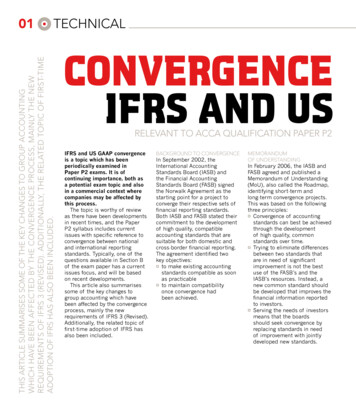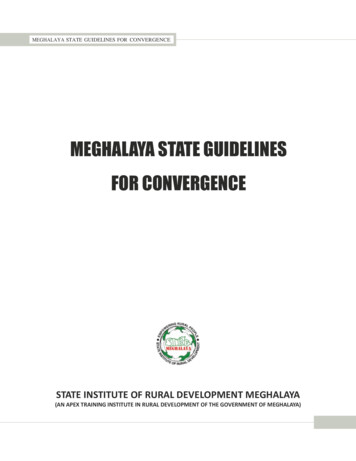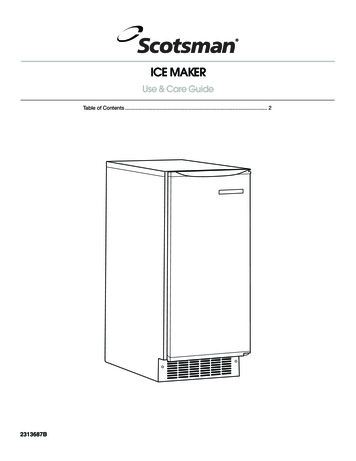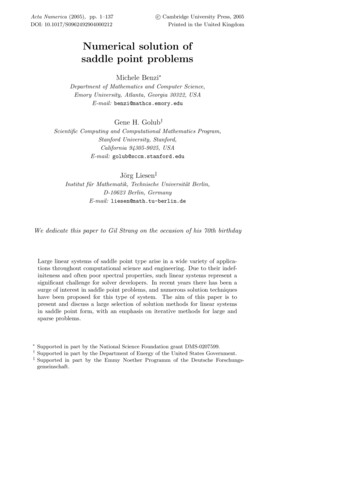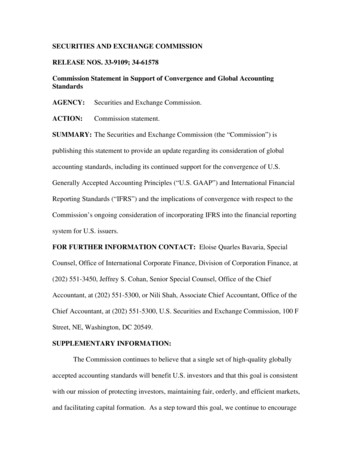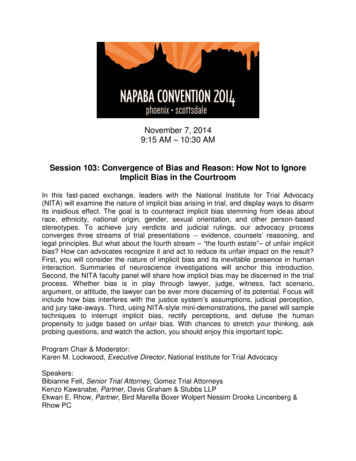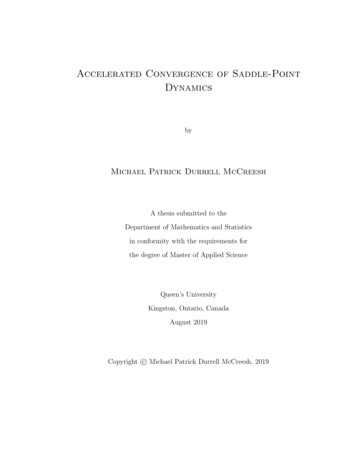
Transcription
Accelerated Convergence of Saddle-PointDynamicsbyMichael Patrick Durrell McCreeshA thesis submitted to theDepartment of Mathematics and Statisticsin conformity with the requirements forthe degree of Master of Applied ScienceQueen’s UniversityKingston, Ontario, CanadaAugust 2019Copyright c Michael Patrick Durrell McCreesh, 2019
AbstractIn this thesis, a second-order continuous-time saddle-point dynamics is introducedthat mimics Nesterov’s accelerated gradient flow dynamics. We study the convergenceproperties of this dynamics using a family of time-varying Lyapunov functions. Inparticular, we study the convergence rate of the dynamics for classes of stronglyconvex-strongly concave functions. For a class of quadratic strongly convex-stronglyconcave functions and under appropriate assumptions, this dynamics achieves globalasymptotic convergence; in fact, further conditions lead to an accelerated convergencerate. We also provide conditions for both local asymptotic convergence and localaccelerated convergence of general strongly convex-strongly concave functions.i
AcknowledgmentsI would like to thank my supervisor, Professor Bahman Gharesifard, for his helpand guidance throughout my time at Queen’s. From hiring me as a summer studentthrough supervising my Master’s, without his advice and belief in me, I would notbe where I am today.As well, I would like to express my graditude to Professor Serdar Yüksel, both forhis supervision of my Honours thesis and his encouragement during my Master’sdegree.Finally, I would like to thank my family and friends for all of their support and helpalong the way. I couldn’t have done it without you all.ii
er 1:Introduction1.1 Statement of Contributions . . . . . . . . . . . . . . . . . . . . . . .1.2 Organization . . . . . . . . . . . . . . . . . . . . . . . . . . . . . . .Chapter 2:Background2.1 Mathematical Preliminaries . . . . . . . . . . . . . . .2.2 Lyapunov Theory . . . . . . . . . . . . . . . . . . . . .2.3 Gradient Descent . . . . . . . . . . . . . . . . . . . . .2.4 Accelerated Gradient Descent Methods . . . . . . . . .2.5 Variational Approach to Accelerated Gradient Descent2.5.1 Discretization . . . . . . . . . . . . . . . . . . .2.5.2 Strongly Convex Functions . . . . . . . . . . . .2.6 Constrained Optimization and Saddle Points . . . . . .123.55791115182022Chapter 3:Problem Statement3.1 Rate of Convergence . . . . . . . . . . . . . . . . . . . . . . . . . . .2527.Chapter 4:Quadratic Results294.1 Asymptotic Convergence of Strongly Convex-Strongly Concave QuadraticFunctions . . . . . . . . . . . . . . . . . . . . . . . . . . . . . . . . . 294.2 Fast Convergence of Strongly Convex-Strongly Concave Quadratic Functions . . . . . . . . . . . . . . . . . . . . . . . . . . . . . . . . . . . . 39Chapter 5:5.1Fast Convergence for Strongly Convex-Strongly Concave Functions50Asymptotic Convergence of Strongly Convex-Strongly Concave Functions 50iii
5.25.3Fast Convergence of Strongly Convex-Strongly Concave Functions . .Corollaries . . . . . . . . . . . . . . . . . . . . . . . . . . . . . . . . .Chapter 6:Examples and Simulations6.1 Simulations of Quadratic Results . .6.2 Quartic Examples . . . . . . . . . . .6.3 Weighted Convergence Function . . .6.4 Trigonometric Example . . . . . . . .6067.7374758086Chapter 7:Conclusions and Future Work7.1 Summary . . . . . . . . . . . . . . . . . . . . . . . . . . . . . . . . .7.2 Future Work . . . . . . . . . . . . . . . . . . . . . . . . . . . . . . . .898990Bibliography92iv.
1Chapter 1IntroductionRecently, the scale of applications of both constrained and unconstrained optimizationproblems has increased dramatically, leading to the need for algorithmic solutions thatcan achieve faster convergence rates. While classical higher-order gradient methodscan be a suitable candidate, these algorithms are impractical for large-scale problemsdue to their computational demand. As such, finding lower-order gradient algorithmsthat can achieve accelerated convergence rates is of importance.The study of accelerated methods for gradient flow dynamics has been an activearea of research over the last few decades. Momentum methods were initially introduced by Polyak [29], while the most well-known is Nesterov’s classical acceleratedgradient flow dynamics [22]. These methods have had a large impact on many areasin optimization, including composite optimization [27], stochastic optimization [16]and nonconvex optimization [12], as well as machine learning [18]. Up until recently,the majority of research on accelerated gradient flow dynamics has been in discretetime; the continuous-time version of Nesterov’s accelerated gradient flow dynamicswas recently proposed in [33] as a second-order differential equation. This has led tothe characterization of a suite of continuous-time accelerated gradient flow dynamics.
1.1. STATEMENT OF CONTRIBUTIONS2A key property of these dynamics is that, through a careful discretization [36, 5], theyprovide variants of Nesterov’s accelerated gradient flow dynamics in discrete time.Many applications which involve optimizing an objective function are howeverconstrained; consider, for example, the problem of maximizing distance traveled subject to a restraint on fuel consumption. Here, one is interested in finding dynamicswhich converge to the saddle points of the corresponding Lagrangian. Such dynamics(known as saddle-point or primal-dual dynamics) in discrete time have been studied extensively in the literature, see for instance [20, 26, 19]. More recently, accelerated convergence rates for primal-dual problems have been studied in discretetime [11, 37, 32].The study of continuous-time saddle-point dynamical systems for constrained optimization goes back to [1]; the recent work [7] extends these classical results in severaldirections by utilizing techniques from Lyapunov theory and nonsmooth analysis toprovide conditions under which these dynamical systems are provably asymptoticallyconvergent to the set of saddle points. However, the characterization of their asymptotic convergence rate remains challenging; recent progress can be found in [6, 8, 30].The main objective of this work is to characterize continuous-time dynamical systemsthat achieve accelerated convergence rates for constrained optimization problems.1.1Statement of ContributionsThe main contribution of this work is the design of the continuous-time dynamicsthat mimics Nesterov’s accelerated flow in both the primal and dual updates. Westudy the convergence properties of this dynamics for strongly convex-strongly concave functions and provide the following three contributions.
1.2. ORGANIZATION3First, in Theorems 4.1.1 and 4.2.1, conditions for the fast convergence of a classof strongly convex-strongly concave quadratic functions are provided. In particular,by designing a time-varying Lyapunov candidate, we prove that under appropriateassumptions involving the coupling of the two arguments of the underlying stronglyconvex-strongly concave quadratic function, the trajectories of the dynamical systemapproach the saddle point at a fast rate, in the same sense as the one in [36] forgradient flows.Secondly, Theorems 5.1.1 and 5.1.3 provide conditions for the asymptotic convergence of strongly convex-strongly concave functions by considering the functionsas a combination of their quadratic component and their non-quadratic componentsseparately. Then, by utilizing both perturbation and Lyapunov arguments, localasymptotic convergence is proven.Finally, Theorem 5.2.1 proves that, given appropriate assumptions, the proposeddynamics achieves a locally exponential convergence rate for strongly convex-stronglyconcave functions.1.2OrganizationThis thesis is organized as follows: In Chapter 2, mathematical preliminaries, and anoverview of gradient flow dynamics, saddle-point dynamics, and their respective convergence rates is provided. In Chapter 3, the dynamics (3.2) are presented, and theconcept of rate of convergence is presented. Chapter 4 provides results on the convergence properties of the dynamics (3.2) for strongly convex-strongly concave quadraticfunctions. In Chapter 5, we present results on the convergence of the dynamics forgeneral strongly convex-strongly concave functions, along with corollaries on specific
1.2. ORGANIZATION4cases of quartic functions. Examples and simulations of the results are presented inChapter 6. Finally, in Chapter 7 future research directions are discussed.
5Chapter 2Background2.1Mathematical PreliminariesThroughout this work, we let R, R 0 , R 0 , Z, Z 0 denote the set of real, nonnegativereal, positive real, integer, and positive integer numbers, respectively. For n, m Z 0 ,the set of real-valued n m matrices is denoted Rn m . We denote the values of goldenratio, i.e. the roots of φ2 φ 1 0, by 1 5φ1 2 1 5and φ2 .2A positive-definite (respectively positive-semidefinite) symmetric matrix A Rn n ,is denoted by A 0 (respectively A 0). We label the eigenvalues of a symmetricmatrix A Rn n by λ1 (A) λ2 (A) · · · λn (A). The n n identity matrix isdenoted by In . We denote the zero vector by 0.A function F : Rn Rm R is convex-concave if it is convex in the first argumentand concave in the second. A differentiable function f : Rn R is strictly convex if
2.1. MATHEMATICAL PRELIMINARIES6for all x, y Rn , it satisfiesf (y) f (x) f (x) (y x).A differentiable function f : Rn R is µ-strongly convex if for some µ 0, and forall x, y Rn , it satisfiesf (y) f (x) f (x) (y x) µkx yk2 .2A function F : Rn Rm R is µ-strongly convex-strongly concave if it is µ-stronglyconvex in the first argument and µ-strongly concave in the second. A saddle point(x , y ) Rn Rm of F satisfiesF (x , y) F (x , y ) F (x, y ),for all x Rn and y Rm . For a differentiable strongly convex-strongly concavefunction, x F (x , y ) y F (x , y ) 0 if and only if (x , y ) is the saddle point ofF.A function f : Rn Rm is L-Lipschitz continuous if for some L 0, and for allx, y Rn , f (x) f (y) L x y . The proofs of many of our results rely on thefollowing results from matrix theory.Definition 2.1.1. (Kronecker Product [15]): Let A Rm n and B Rp q . Then
2.2. LYAPUNOV THEORY7the Kronecker Product of A and B is denoted by A B and is defined as a11 B . . . a1n B . .A B . , am1 B . . . amn Bwhich lies in Rmp nq .Theorem 2.1.2. (Weyl and Dual Weyl Inequalities [14]): Let A and B besymmetric matrices in Rn n . Then for 1 i, j n and i j 1 n, the Weylinequality holds, i.e.,λi j 1 (A B) λi (A) λj (B).Similarly, for 1 i, j n and i j n 1, the dual Weyl inequality holds, i.e.,λi j n (A B) λi (A) λj (B).Theorem 2.1.3. (Sylvester’s Criterion [14]): Let A be a symmetric matrix inRn n . Then A is positive-semidefinite if and only if all of the principal minors ofA are nonnegative. Further, A is positive-definite if and only if all of its leadingprincipal minors are positive.2.2Lyapunov TheoryWe now recall classical Lyapunov theory, in particular Lyapunov’s second method,which is a useful tool for proving the convergence of a dynamical system. For a map
2.2. LYAPUNOV THEORY8f : Rn Rn , consider the autonomous dynamical systemẋ f (x).(2.1)Before continuing we provide the following definitions.Definition 2.2.1. (Equilibrium Point [17]): An equilibrium point of the system (2.1) is a point x such that f (x ) 0.Definition 2.2.2. (Stability [17]): An equilibrium point x is: locally stable if, for each 0, there exists δ δ( ) 0 such that x(0) x δ x(t) x ,for all t 0. locally asymptotically stable if it is stable and δ can be chosen such that x(0) x δ lim x(t) x .t Without loss of generality we can assume that 0 is an equilibrium point of (2.1).A Lyapunov function is defined as followsDefinition 2.2.3. (Lyapunov function [17]): Let V : Rn R be a continuouslydifferentiable function such that the following hold V (0) 0. V (x) 0 for all x U\{0}, where U Rn is a neighbourhood including theorigin.
2.3. GRADIENT DESCENT Lf V (x) V dx x dt9 0 for all x U where Lf is the Lie derivative of V along theflow f , given by (2.1).Then V is a Lyapunov function for the dynamical system (2.1).We now provide Lyapunov’s second method.Theorem 2.2.4. (Lyapunov’s Second Method [17]): Consider the dynamicalsystem (2.1). If there exists a Lyapunov function V for the system (2.1) on a neighbourhood U, the equilibrium point x 0 is locally stable. Furthermore, if the Lyapunovfunction additionally satisfiesLf V (x) 0for all x U\{0}, the equilibrium point is locally asymptotically stable.2.3Gradient DescentWe now discuss the classical unconstrained optimization problem and consider avariety of algorithms used to determine solutions. In particular, we focus on firstorder gradient schemes and their corresponding convergence rates. The problem isdefined as follows: Let f : Rn R be a continuously differentiable convex function.The unconstrained optimization problem is thenmin f (x).x Rn(2.2)A classical method for determining solutions of (2.2) is gradient descent [3], and canbe described both by a discrete-time algorithm or a continuous-time dynamics. The
2.3. GRADIENT DESCENT10continuous-time dynamics is given byẋt f (xt ).(2.3). Meanwhile, the discrete-time iterative algorithm is given byxk 1 xk k f (xk ),(2.4)where k R 0 is the step-size of the algorithm at iteration k, and the sequence{ k }k Z 0 satisfies Xk 1 2k X k .k 1In both the iterative algorithm and the ODE framework, the equilibrium points arethe solutions to (2.2). The drawback of the classical gradient descent method givenabove is that convergence to a solution of (2.2) is slow. In particular, if x is a suchsolution, for the discrete-time algorithm [33], and similarly the continuous-time case,the gradient descent method achieves the ratesf (xk ) f (x ) O(1/k). As such, while effective, methods for solving (2.2) achieving faster rates have beenresearched extensively.
2.4. ACCELERATED GRADIENT DESCENT METHODS2.411Accelerated Gradient Descent MethodsThe research on improving the convergence rate of optimization schemes to solvethe problem (2.2) has led to the introduction of momentum and accelerated gradientdescent methods. The first results on momentum methods can be attributed toPolyak [28, 29]. Polyak proposed the following dynamics [29] as a method of obtaininga faster rate of convergence than classical gradient descent,mẍt f (xt ) mẋt ,(2.5)where m R 0 can be considered as ‘mass’. This dynamics was presented with thecorresponding discretizationxk 1 xk f (xk ) m(xk xk 1 ).(2.6)This method is called the Heavy Ball Method, as (2.5) matches the equation for themotion of a body with mass m in a potential field. The term mẋt in (2.5), respectively,m(xk xk 1 ) in (2.6), is the ‘momentum’ term, adding the weight of the previous stepto the current step. While this method achieves faster convergence for some classesof functions, only local convergence of the result was proved in the original work ofPolyak, and that is under the assumption of strong convexity [29].Following Polyak’s work, there was minimal work on solving (2.2) using momentumbased dynamics until recently. Instead, the research focused on ‘accelerated’ gradient
2.4. ACCELERATED GRADIENT DESCENT METHODS12descent methods proposed by Nesterov in 1983. In [22], Nesterov proposed the following discrete-time accelerated gradient descent algorithmxk yk 1 s f (yk 1 )y k xk k 1(xk xk 1 ),k 2(2.7a)(2.7b)where s is the fixed step-size. This algorithm was proved to solve (2.2) with thefollowing rate:Theorem 2.4.1. ([22, Theorem 1]): Let f : Rn Rn be a convex function with aL-Lipschitz continuous gradient and minimizer x . Then, if the sequence {xk }k Z 0is constructed as in (2.7), with s 1/L,f (xk ) f (x ) O(1/sk 2 ).This result was proved using the method of estimate sequences, which are definedas follows.Definition 2.4.2. (Estimate Sequence [23]): A pair of sequences {φk (·)}k Z 0and {λk }k Z 0 , λk 0, is called as estimate sequence of a function f : Rn R iflim λk 0k and for any x Rn and all k 0 we haveφk (x) (1 λk )f (x) λk φ0 (x).
2.4. ACCELERATED GRADIENT DESCENT METHODS13By the following result, it is clear that an estimate sequence is useful in that theconvergence rate of the algorithm can be derived directly from the rate of convergenceof the sequence {λk }.Lemma 2.4.3. ([23, Lemma 2.2.1]): If for some sequence {xk }k Z 0 we havef (xk ) φ k minn φk (x),x Rthen f (xk ) f (x ) λk (φ0 (x ) f (x )).As the estimate sequence technique allows for the direct derivation of the rateof convergence, modifications of Nesterov’s original algorithm (2.7) were suggestedusing estimate sequences. These include [2] and [25], achieving rates of O(1/k 2 ) andO(1/k 3 ), respectively.Recently, there has been a significant amount of research connecting Nesterov’saccelerated gradient descent algorithms with a continuous-time approach to the optimization problem (2.2) (see, for example, [9, 10]). In particular, in [33] the exactcontinuous-time limit of the algorithm (2.7) is determined. This limit is the followingsecond-order ordinary differential equation (ODE)3ẍt ẋt f (xt ) 0,t(2.8)with the relation between the step size in (2.7) and the time parameter t in being t k s, see [33]. It is interesting to note that Nesterov’s first-order acceleratedgradient descent scheme is modeled by a second-order ODE. The following resultillustrates that the convergence rate achieved in (2.7) is maintained by the ODE (2.8).Theorem 2.4.4. ([33, Theorem 3]): Let f : Rn R be a convex, continuously
2.4. ACCELERATED GRADIENT DESCENT METHODS14differentiable function with a Lipschitz-continuous gradient and let x be the minimizerof f . Then if xt is the unique global solution to (2.8), with initial condition x0 andẋ0 0,f (xt ) f (x ) O(1/t2 ),for all t 0.Another point of interest is that the constant 3 in the second term of (2.8), whichcomes from Nesterov’s original algorithm (2.7), can be replaced by any larger valuewhile still maintaining the convergence rate of O(1/t2 ). Using this fact, for stronglyconvex functions, a faster convergence rate can be proven.Theorem 2.4.5. ([33, Theorem 8]): Let f : Rn R be a µ-strongly convex,continuously differentiable function with minimizer x . Then, if Xt is the solution tothe ODErẍt ẋt f (xt ) 0,twhere r 3, we have2rf (Xt ) f (x ) O(t 3 ).This connection has led to further research on accelerated methods through ODEs,including from a variational framework in [35] and [36], which we discuss next.
2.5. VARIATIONAL APPROACH TO ACCELERATED GRADIENTDESCENT152.5Variational Approach to Accelerated Gradient DescentBefore discussing the variational approach to accelerated gradient descent methods forsolving the problem (2.2) taken in [35] and [36], we require the following definitions.Definition 2.5.1. (Bregman Divergence [35]): Let h : Rn R be a distancegenerating function that is continuously differentiable and convex. Then, the Bregmandivergence is defined asDh (y, x) h(y) h(x) h h(x), y xi.An important case of the Bregman Divergence is the Euclidean case, where h(x) 1kxk2 .2In this case Dh (y, x) 12 ky xk2 .Definition 2.5.2. (Bregman Lagrangian [35]): Let T R 0 be an interval oftime and let Xt , Vt : T Rn be continuously differentiable curves. Let αt , βt , γt :R 0 R be arbitrary smooth functions satisfyingβ̇t eαt(2.9a)γ̇t eαt .(2.9b)For a continuously differentiable convex function f : Rn R, the Bregman Lagrangian is the map BL : Rn Rn R R defined by BL (Xt , Vt , t) eαt γt Dh (Xt e αt Vt , Xt ) eβt f (Xt ) .Before continuing, we make the following remark.(2.10)
2.5. VARIATIONAL APPROACH TO ACCELERATED GRADIENTDESCENT16Remark 2.5.3. The curves Xt and Vt can be considered as position and velocityfunctions, respectively. Then, the functions αt , βt and γt represent the weightingof the velocity, Vt , the potential function, f , and the damping of the Lagrangian,respectively, while the equations in (2.9) are known as the ideal scaling conditions. We now define the variational problem presented in [35] and [36] used to solvethe problem (2.2). First, let T [t0 , t1 ] be an interval of time and denote the setof all continuously differentiable curves X : T Rn satisfying boundary conditionsX(t0 ) x0 and X(t1 ) x1 by X. The variational problem is then defined as: LetBL : Rn Rn R R be the Bregman Lagrangian. Then, over the set of curves X,minimize the functionalZBL (X(t), Ẋ(t), t)dt.J(X) TA necessary condition for a curve to minimize the functional J is that it solves theEuler-Lagrange equation (see, for example, [4, Theorem 4.38]). Following [35], under the ideal scaling conditions (2.9), the Euler-Lagrange equation for the BregmanLagrangian is found to behi 1Ẍt (eαt α̇t )Ẋt e2αt βt 2 h(Xt e αt Ẋt ) f (Xt ) 0.(2.11)This can also be written asd h(Xt e αt Ẋt ) eαt βt f (Xt ),dt(2.12)which removes the requirement of invertibility of the Hessian of h. The following
2.5. VARIATIONAL APPROACH TO ACCELERATED GRADIENTDESCENT17theorem gives that the solutions of the Euler-Lagrange equation (2.11) solve theminimization problem (2.2) at an accelerated rate.Theorem 2.5.4. ([35, Theorem 2.1]): If the ideal scaling conditions (2.9) holds,the solutions to the Euler-Lagrange equation (2.11) satisfyf (Xt ) f (x ) O(e βt ),where x is the minimizer of the function f .This result is proved using a time-varying Lyapunov function, an approach thatwill be used throughout this thesis.Now, we discuss the relationship between the solutions to the variational problemand the accelerated gradient descent methods. Consider the Bregman Lagrangianwith the following parameters, indexed by p 0,αt log p log t(2.13a)βt p log t log C(2.13b)γt p log t,(2.13c)for some constant C 0. These parameters satisfy the ideal scaling conditions (2.9)and lead to the following Euler-Lagrange equation 1tp 12 p 22Ẋt Cp t h Xt Ẋt f (Xt ) 0.Ẍt tp(2.14)By Theorem 2.5.4, the convergence rate achieved is O(1/tp ), which when p 2matches the continuous-time limit of both Nesterov’s accelerated mirror descent
2.5. VARIATIONAL APPROACH TO ACCELERATED GRADIENTDESCENT18scheme [24] and when p 3, the continuous-time limit of Nesterov and Polyak’saccelerated cubic-regularized Newton’s method [25]. Furthermore, in the Euclideancase, when p 2, we have that (2.14) is equal to the continuous-time limit of Nesterov’s accelerated gradient descent scheme (2.8), found in [33].2.5.1DiscretizationAs the variational continuous-time approach presented in [35] and [36] is used toprovide a more intuitive way to understand accelerated gradient descent schemessuch as those presented by Nesterov (as in [22, 24, 25]), it is necessary to be ableto directly relate the ODEs with a discrete-time algorithm. As such, discretizationsof the ODEs generated by the Euler-Lagrange equations of the Bregman Lagrangianmust be studied.We now discuss the discretization of (2.14) to provide discrete-time acceleratedgradient descent algorithms achieving convergence rates matching Nesterov’s originalalgorithm (2.7). First, (2.14) can be written as the following system of equations:tzt xt ẋtp(2.15a)d h(zt ) Cptp 1 f (xt ).dt(2.15b)In [35], it is shown that under a standard Euler discretization, these dynamics donot necessarily converge, let alone provide a convergence rate of O(1/ k p ) (where R 0 is the step size of the discretization), even though the continuous-timedynamics provide a rate of O(1/tp ). However, using a discretization that maintainsthree sequences, based upon Nesterov’s accelerated mirror descent [24] and accelerated
2.5. VARIATIONAL APPROACH TO ACCELERATED GRADIENTDESCENT19cubic-regularized Newton’s method [25], one can obtain an accelerated convergencerate. From [35], consider the following discretization of (2.15)pkzk ykk pk p 1(p 1)zk argmin Cpkh f (yk ), zi Dh (z, zk 1 ) . zxk 1 (2.16a)(2.16b)Here k (p 1) denotes the rising factorial, that is k (p 1) k(k 1).(k p 2). In thisdiscretization a third sequence, {yk }k Z 0 is maintained for updating the sequence{xk }k Z 0 . In order to achieve the convergence rate O(1/ k p ), this sequence mustsatisfy the following condition1ph f (yk ), xk yk i M p 1 k f (yk )k p 1 ,(2.17)in which M is a constant greater than 0, and k · k denotes the operator norm. Thiscondition is arbitrary, in that it is constructed such that the proof of the followingresult holds. Before providing the result we require the following definition on uniformconvexity.Definition 2.5.5. (Uniform Convexity [35]): Let h : Rn R be a distancegenerating function and let p Z 0 \{1}. Then h is σ-uniformly convex of order p if,for all x, y Rn ,Dh (y, x) σ y x p .pWe note that the case when p 2 is the definition of strong convexity. We nowprovide the result on the convergence rate of (2.16).
2.5. VARIATIONAL APPROACH TO ACCELERATED GRADIENTDESCENT20Theorem 2.5.6. ([35, Theorem 3.1]): Let h : Rn R be 1-uniformly convex oforder p 2, and suppose the sequence {yk } satisfies (2.17) for all k 0. Then ifC M p 1 /pp , the algorithm (2.16) with initial condition x0 z0 has the convergencerate f (yk ) f (x ) O1 k p .Further discretizations of the Euler-Lagrange equation (2.11) explored using discretetime Lyapunov functions can be seen in [36]. In these results, the ideal scaling condition (2.9a) is chosen such that β̇t eαt . In this work, we will focus on anotherdynamics derived from the Bregman Lagrangian for the case of strongly convex functions.2.5.2Strongly Convex FunctionsIn this section, and for the remainder of the thesis, we consider the standard Euclideandistance function, that is h(x) 21 kxk2 . Following [36], for a strongly convex functionf : Rn R, consider the following dynamics1(zt xt )β̇tβ̇tżt ẋt f (xt ).µ(2.18a)ẋt (2.18b)This dynamics is the Euler-Lagrange equation for the following Lagrangian, closelyrelated to the Bregman Lagrangianγt βt αtL(x, ẋ, t) e µ2 2αte kẋk f (x) .2(2.19)
2.5. VARIATIONAL APPROACH TO ACCELERATED GRADIENTDESCENT21Using the fact that the function f is strongly convex rather than just convex, thedynamics (2.18) can achieve an exponential convergence rate.Proposition 2.5.7. ([36]): Let f : Rn R be a µ-strongly convex function withminimizer x . Then, under the dynamics (2.18)f (xt ) f (x ) O(e βt ).As this result is proven for a general smooth function βt , an exponential rate isachieved, rather than the polynomial rate achieved by (2.15). However, one shouldnote that depending on the choice of βt , these dynamics can produce a multitudeof convergence rates, which can be seen by the choice of βt leading to the dynamics (2.15). Of further interest, however, is that the following discretization of thedynamics (2.18) 1zk 1 zk τk xk zk f (xk )µτk (xk zk ) yk xkyk 1 xk 1 f (xk ),L(2.20a)(2.20b)(2.20c)in which τk is the discretization of β̇t and L is the Lipschitz coefficient of the gradient off , maintains the exponential convergence rate [36]. To conclude this section, we notethat since the dynamics (2.18), and its discretization (2.20), achieve a convergence rateexceeding the polynomial rate provided by Nesterov’s algorithm and other variantsof it provided earlier, a modification of this dynamics will be considered in the mainresults of this work.
2.6. CONSTRAINED OPTIMIZATION AND SADDLE POINTS2.622Constrained Optimization and Saddle PointsThe results and dynamics described in the preceding sections are all effective methods for solving the unconstrained optimization problem (2.2). However, in manyengineering applications, it is common to see constrained optimization problems ofthe following form:Let f : Rn R be a convex, continuously differentiable function and let I, J Z 0 . Let {hi }i I and {gj }j J be collections of smooth functions. Then consider theproblemmin f (x)x Rnsubject to hi (x) 0gj (x) 0.(2.21)To solve the problem (2.21), the gradient descent methdods described above areno longer sufficient. Instead, one is interested in finding dynamics that convergeto the saddle points of the Lagrangian associated with the function. Saddle-pointdynamics (also known as primal-dual dynamics) are the natural analogues to gradientdescent dynamics for constrained optimization. The first research into continuoustime saddle-point dynamical systems appears in [1], with the Arrow-Hurwicz methodfor finding the saddle points.Theorem 2.6.1. (Arrow-Hurwicz Gradient Method [1]): Let F : Rn Rn R be a continuously differentiable strictly convex-strictly concave function. Then,
2.6. CONSTRAINED OPTIMIZATION AND SADDLE POINTS23consider the following system of differential equations:ẋ x F (x, y)(2.22a)ẏ y F (x, y).(2.22b)Then, if (x(t), y(t)) is a solution to the system (2.22) with initial condition (x0 , y0 ),and (x(t), y(t)) converges to a point (x , y ), (x , y ) is a saddle point of f .Note that for general convex-concave functions, the Arrow-Hurwicz method willnot necessarily converge. Recently, in [7], techniques from Lyapunov theory and nonsmooth analysis have been utilized to provide conditions under which these dynamicsare convergent to the set of saddle points for more general classes of functions. Thefollowing result proves asymptotic stability for strictly convex-concave and convexstric
ow dynamics, saddle-point dynamics, and their respective con-vergence rates is provided. In Chapter 3, the dynamics (3.2) are presented, and the concept of rate of convergence is presented. Chapter 4 provides results on the conver-gence properties of the dynamics (3.2) for strongly convex-strongly concave quadratic functions.

